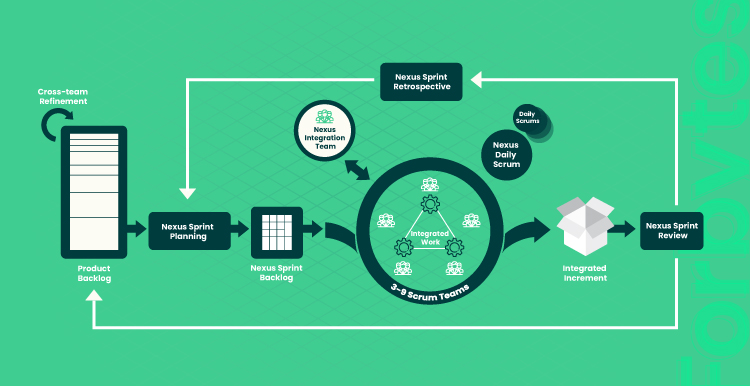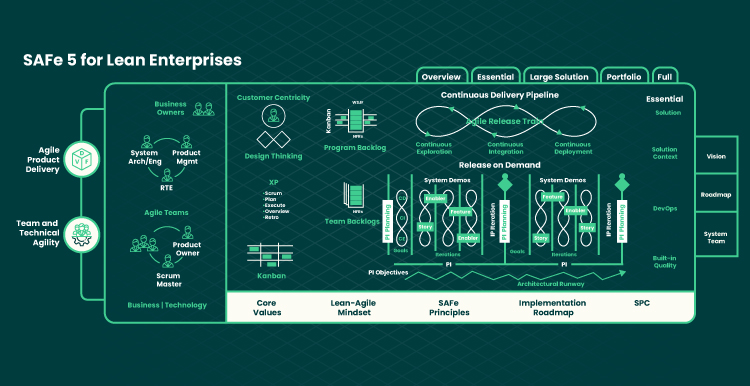If you’ve ever worked on a software project that dragged on for months only to miss the mark with users, you’re not alone. That’s where the Agile software development life cycle (SDLC) comes in.
Agile isn’t just a buzzword. It’s a mindset and a proven framework for software development that works for your users, not just looks good in theory. Whether you’re launching a startup app or modernizing an enterprise system, understanding the Agile life cycle helps you stay flexible, deliver faster, and respond to change like a pro. By breaking the development process into smaller, iterative cycles, Agile makes it easier to adapt to feedback, fix issues early, and maintain steady progress toward a better end product. This approach supports continuous improvement, allowing teams to refine their workflows, enhance product quality, and respond to changing user needs with every iteration.
In this guide, we’ll walk you through how the Agile SDLC works, why it matters, and how you can use it to build better products with fewer surprises. Ready to rethink how your team builds software? Let’s dive in.
What Is Agile Software Development?
Before starting the detailed analysis of the Agile development life cycle, let’s draw a quick overview of the methodology.
The term “Agile lifecycle” was first introduced in 2001 by a group of software developers and managers seeking a more effective way to organize the software development process. On February 11-13, seventeen experts met together at The Lodge at Snowbird Ski Resort in Utah and composed a short document that became famous as the Agile Manifesto. Among the co-authors of the Manifesto, we can find such well-known experts as:
- Jeff Sutherland (creator of the Scrum methodology)
- Ken Schwaber (president of Advanced Development Methods, who helped Sutherland formalize Scrum)
- Mike Beedle (CEO of e-Architects Inc., and one of the first adopters of Scrum)
- Robert C. Martin (a veteran C++ developer and theorist of the software development principles and practices)
- Brian Marick (a prominent Ruby programmer and tester).
As you can see, Agile development was theorized and tested inside the Scrum community gathered in the early 1990s. Although it repeats and expands on the principles of Scrum in many ways, it remains distinct. While Scrum implies mostly the methodology of managing teamwork, the term Agile usually identifies the method of project stage structuring. Today, Agile is widely adopted by software development teams to improve collaboration, adapt to change, and deliver value faster. Its flexible approach to the entire development cycle allows teams to iterate quickly and respond effectively to evolving project needs.
Core Principles of the Agile Software Development Life Cycle
The initial reason why the Snowbird 17 met together was the feeling of frustration that originated from the experience of software development. After years of work, group members noticed that the focus of current software development shifted from satisfying a client to excessive project planning and product documentation. Snowbird 17 wanted to change things back. After three days of discussion, they forged four short maxims that conceptualized their vision of a new software development paradigm.
The ideas formulated in the Manifesto appeared so genuine that they became a core of corporate culture for many companies. At Forbytes, we follow the Agile principles as well.
Ready to make Agile work for your team? Let’s talk about how we can help you implement the Agile software development life cycle with confidence.
What Are the Phases of Agile Methodologies?
While the exact number of agile phases may vary, six stages compose the core of the agile software development cycle: concept, inception, iteration, delivery, support, and end of use.
Concept
Everything begins with a concept. At this initial stage, a Product Owner prioritizes the most important project and determines its scope, a list of tasks required to deliver the product. To prepare the concept, the Product Owner conducts product discovery. A meeting with key stakeholders is organized, their needs and problems are discussed, and possible solutions are proposed. In the end, the Product Owner provides the plan for future work as well as a rough order of magnitude.
Inception
Once the project outline is scratched, it’s time to begin the work. A Project Manager assembles the team and assigns the first tasks. While starting a project, developers must be supplied with all the required resources, including physical and virtual infrastructure. Establishing a clear and well-structured development process at this stage ensures smooth collaboration, faster progress, and fewer roadblocks as the project evolves.
An iterative approach allows the team to continuously refine the product through repeated cycles, incorporating feedback and making improvements throughout the development process.
Iteration (construction phase)
The next step is the iteration phase, also known as the construction phase. This is the most time-consuming period of a project, as it’s when the actual product is developed. The construction phase is structured into a series of Agile iterations, or sprints, short timeframes where a limited amount of work is completed and tested. The goal is to deliver a functioning product at the end of the very first iteration.
Release and testing
Before deploying a product for mass consumption, a separate testing team must ensure that it functions well and is free of serious bugs. User training is also required. This phase marks the final stage of the development cycle, where all components are validated before the product goes live. In some cases, early customer feedback gathered during testing can be used to fine-tune final features and enhance the user experience.
Maintenance
Once a product is deployed and available to users, it enters the maintenance phase. The development team provides ongoing support, resolves bugs, and addresses new malfunctions. Feedback is continuously collected from clients, and a list of missing or desired features is maintained.
Eventually, upgraded versions may be released. This entire phase reflects the principle of continuous improvement, where real-world insights guide ongoing development. This aligns perfectly with the Agile model, which emphasizes flexibility, iteration, and responsiveness throughout the product lifecycle.
Retirement
The product served well, but now it’s time to replace it with a newer version. The product publisher notifies clients about the end-of-use and begins the retirement process. Support during migration to a replacement system is essential. Finally, software development teams perform the last end-of-life activities and close support.
Even during this phase, Agile practices like iterative planning and continuous communication ensure a smooth transition and minimal disruption for users. This highlights how a flexible software development methodology supports every stage of the product lifecycle, including retirement.
How An Agile Team Is Built
Agile roles are distributed in a way that the development process can stay flexible and scalable. By choosing the right Agile team structure, you will arrange activities, processes, and workflows effectively. Here are some of the characteristics the development team structure should possess to be called Agile:
- Cross-functionality is highly favored. Agile team roles are clearly defined, but are not limited to particular aspects of work. The goal is to deliver quality products on time and satisfy the client. If cross-functional activities and the exchange of experience facilitate product development, team members are only welcome to mix their skills and knowledge. This flexible and collaborative structure is a hallmark of agile development methods, which prioritize adaptability, teamwork, and delivering customer value over rigid role definitions.
- There is no hierarchy. The agile structure says no to the hierarchy implemented in traditional approaches. Instead, a cross-functional Agile team uses a flat structure under which team members work independently of each other and organize their tasks by themselves.
- Collaboration is the key. Regardless of Agile team size, everyone has to support collaboration not only within a team but also across teams. Open communication, cross-training, readiness to help, and knowledge-sharing are the features valued and promoted under the Agile approach.
As you see, Agile teams differ from traditional ones in a number of aspects. Traditional teams are based on a hierarchical structure, which triggers competition and adversely affects communication and cooperation. Unlike the traditional approach, Agile software development doesn’t drive internal rivalry. This method unites teams and individuals under shared goals.
Agile teams can be organized in several ways depending on the project’s complexity, goals, and required expertise. The five common structures include:
-
Generalist Teams
-
These software development teams have a broad understanding of multiple areas.
-
Not limited to specific tasks, they can easily switch focus.
-
Ideal for projects requiring flexibility and quick adaptation.
-
-
Specialist Teams
-
Composed of individuals with deep expertise in a specific niche.
-
Each member is responsible for their specialized domain.
-
Best for solving complex problems in targeted areas.
-
-
Hybrid Teams
-
Combine both generalists and specialists.
-
Specialists handle in-depth, technical components.
-
Generalists oversee the broader vision and integration of parts.
-
Useful for balancing depth and coordination across the project.
-
-
Parallel Teams
-
Each team member performs similar tasks simultaneously.
-
Helps speed up delivery but may require strong coordination.
-
-
Subteam Structures
-
A large Agile team is divided into smaller subteams with focused responsibilities.
-
Promotes autonomy while maintaining alignment through shared goals.
-
When you choose the right team model, you need to make sure that you have enough professionals to fulfill the key roles. This is what your typical software development team structure should look like:
- Product owner. A person who represents the interests of a customer. Their task is to clearly communicate client needs and offer guidance.
- Team member. Any individual who works in a team and fulfills a particular role. For instance, UI/UX designer, software engineer, QA tester, etc.
- Team lead. This individual coordinates teamwork, keeps an eye on workflow effectiveness, manages tasks, and organizes meetings.
- Stakeholder. These are people possessing a particular interest in a product as they expect to get benefits after its release. These, for instance, can be product users or investors.
Yet, even when you have all these roles fulfilled by skilled individuals, the management of Agile iterations can be a challenging task. This is why you may need a Scrum master. What are their functions? Let’s discuss it in the next section.
What is the Scrum master’s role in Agile SDLC methodology?
As mentioned earlier, product development within the Agile life cycle primarily occurs during the construction phase. One of the key roles supporting this phase is the Scrum Master.
Core Responsibilities of a Scrum Master
A Scrum Master’s main goal is to guide the team in becoming self-managing and self-sufficient. They play a crucial role in helping the team work efficiently by:
-
Removing obstacles that hinder progress
-
Facilitating Agile ceremonies to ensure they’re productive, focused, and timeboxed
-
Fostering a positive, collaborative environment
-
Aligning with the Product Owner to define the product goal and select backlog items for each sprint
-
Coordinating with stakeholders to maintain transparency and shared expectations
Hiring a Scrum Master: What to Look For
When hiring a Scrum Master, consider the following key aspects:
-
Certification: Look for candidates with official Scrum training. There are three levels of mastery that indicate their understanding and experience.
-
Mindset: A strong Scrum Master believes in self-organization, values sustainable pace, and understands the importance of iteration and rhythm in workflows.
-
Team Fit: Invite your current Product Owner to join the interview process to assess chemistry and compatibility between them—collaboration between these two roles is critical.
Whether you’re building a new team or scaling an existing one, we can help you design a structure that fits your project goals and team dynamics. Contact Forbytes today to get expert guidance on Agile software development.
Why Do You Need Agile Software Development?
Let’s refer once again to the State of Agile Report to understand why so many product managers are shifting toward the Agile project life cycle.
According to the report, the top reasons include:
-
Adapting to changing priorities: Agile’s short sprint cycles make it easier to adjust task priorities based on the evolving product context. This flexibility helps teams deliver features that align more closely with user needs, ultimately leading to greater customer satisfaction and product relevance.
-
Faster product delivery: Many teams adopt Agile to accelerate the release of usable, value-driven product increments. This not only speeds up time to market but also increases customer satisfaction by delivering features users need sooner. Agile practices such as sprint planning, daily stand-ups, and regular retrospectives ensure that teams stay aligned, address blockers quickly, and continuously improve delivery.
-
Improved team productivity: Compared to the traditional Waterfall approach, managers report that Agile software development life cycle helps teams stay more focused, efficient, and responsive. It also brings greater transparency to project management, enabling stakeholders to track progress, adjust priorities, and make informed decisions throughout the development process.
-
Higher product quality: Agile practices and continuous feedback loops often lead to better testing, validation, and outcomes. This focus on iterative development allows teams to make incremental improvements, adapt quickly to change, and reduce the risk of costly rework later on.
-
More accurate delivery forecasting: Agile frameworks like Scrum make it easier to predict release timelines, reducing uncertainty and improving planning accuracy. When combined with continuous integration, teams can detect issues early, maintain code quality, and ensure smoother, more reliable releases. This consistency not only improves team performance but also boosts customer satisfaction by delivering dependable updates and meeting user expectations more effectively.
Variants of Agile Methodologies
The popularity of Agile and its applications in different spheres resulted in the development of several variants of Agile methodology that are adapted for specific business needs.
- One of them is called Nexus. Nexus aims to help Scrum masters scale the Scrum framework for big projects without losing flexibility. A typical Nexus group includes three to nine Scrum teams working together on a single project. All Scrum teams are managed by a single Product Owner, who controls the backlog and assigns the tasks. The agility of the Nexus group relies on the decrease of cross-team dependency and maintaining the team’s self-sufficiency. The success of the Nexus group depends upon how a Product Owner structures the product and how they break it into single units. To get the work done, the Scrum master has to facilitate the communication between teams and make sure that the feedback is received without delay.
- The other solution for complex project management is the Scaled agile framework (SAFe). Under this approach, the agile team size is between 5 and 11 individuals. The problems SAFe addresses derive from the complexity of modern software development caused by the distribution of production multi-nationally, increase in product units and mergers, offshoring, and rapid growth of the demand for a product. To handle those challenges, experts from Scaled Agile, Inc. developed ten principles that help scale the Agile framework. Some of the SAFe principles include:
-
- Develop system thinking
- Be ready for the variability of the market and technical solutions
- Be open-minded to new options
- Increase the speed of production incrementally by constant learning and improvement of Agile iterations
- Limit work in progress and reduce work batch sizes
- Synchronize with cross-domain planning
- Decentralize decision-making
- Organize around the value of a product.
- The third alternative for scaling Scrum to multiple teams is Large-Scale Scrum (LeSS). The LeSS framework aims to reduce the complexity of a project and hence reduce waste. Due to its simplicity, LeSS earned the title of ‘barely sufficient’ framework. Similar to the SAFe, the recommendations of LeSS are also organized into 10 principles:
-
- Large-scale Scrum remains to be the Scrum
- Control process with the empirically obtained data
- Keep the progress of a project as transparent as possible
- While scaling the teams, keep one Product Backlog managed by one Product Owner
- Determine value and waste in the eyes of a client
- Apply lean-thinking
- Learn queuing theory and optimize your questions.
To gain maximum benefit from Agile, you can combine different aspects of the mentioned methodologies in a single project.
Agile Pitfalls
After reading all of the described benefits of agile, you might ask yourself: if agile is so great compared to the waterfall methodology, why is the adoption rate not 100%? Why do some companies deny agile?
The results of the 15th Annual State of Agile Report show that the reason hides in the persistence of thinking. Among the 10 barriers mentioned in the report, the most widespread are:
- Discordance in the existing procedures and routines (checked by 46% of respondents)
- Cultural hostility (checked by 43% of project managers)
- General organizational denial of any kind of changes (mentioned by 46% of team members).
In some cases, product managers are convinced that the Agile process works well only for small teams and will not suit big enterprise-scale projects. Such a belief is nothing more than a misconception. The difficulties of scaling Agile SDLC have been discussed for a long time, and several specialized tactics have been developed.
Dark Agile
The dark side of Agile’s high popularity is its turn into a kind of ‘cargo cult’ project management. Applied without a proper understanding of its core values, Agile becomes nothing more than a magical methodology in name only. The team may start focusing more on following rituals and processes than on delivering real results. To avoid drifting toward the so-called Dark Agile, monitor your work routine for the following warning signs:
- The work discovery phase, design, and production are executed separately by individual teams. Within true Agile development, all the teams should collaborate throughout the whole project.
- The amount of planned work is huge. The team experiences excessive pressure from a Product Owner and hence fails to deliver outputs on time. The real aim of Agile development was to avoid delays by breaking the work into pieces small enough to deliver outputs within short iterations.
- Instead of one Product Owner, there are several people demanding results from the team.
- Outputs became more important for a team than the business results (outcomes).
Final Thoughts
There’s no shortage of methodologies to choose from in today’s fast-paced software development landscape. Whether you’re leading a small, focused team or managing enterprise-level product initiatives, the right framework can make or break your success. Choosing the right approach shapes the entire development process, from how ideas are validated to how features are delivered and improved over time. Ultimately, a well-chosen methodology leads to higher customer satisfaction by ensuring that the final product meets real user needs and expectations.
Agile continues to stand out for its adaptability, transparency, and user-centric approach, thanks in large part to its foundation in iterative development. By breaking work into smaller, manageable cycles, teams can continuously improve and adapt based on real feedback. Yet, despite its popularity, many organizations struggle to implement Agile effectively and stay true to its core principles.
If you’re seeking a skilled Project Manager who truly lives and breathes Agile and knows how to align it with real-world software development needs, reach out to the Forbytes team. We’ll help you find the right expert and guide your project toward meaningful, measurable outcomes.

Our Engineers
Can Help
Are you ready to discover all benefits of running a business in the digital era?

Our Engineers
Can Help
Are you ready to discover all benefits of running a business in the digital era?













